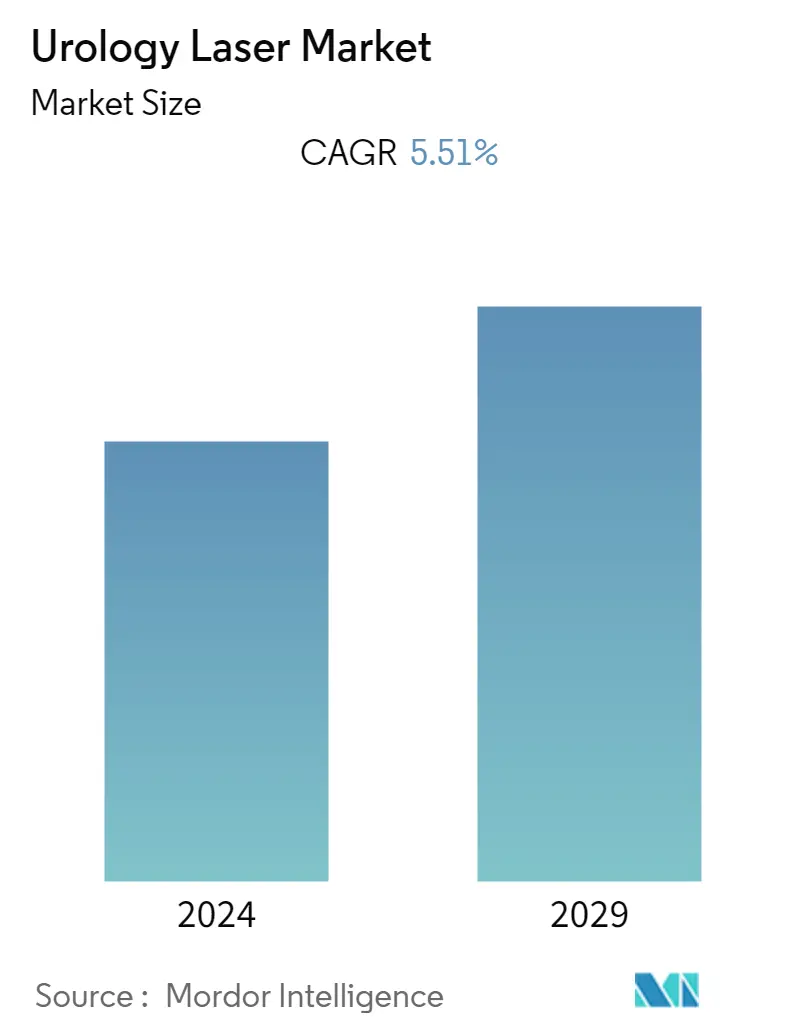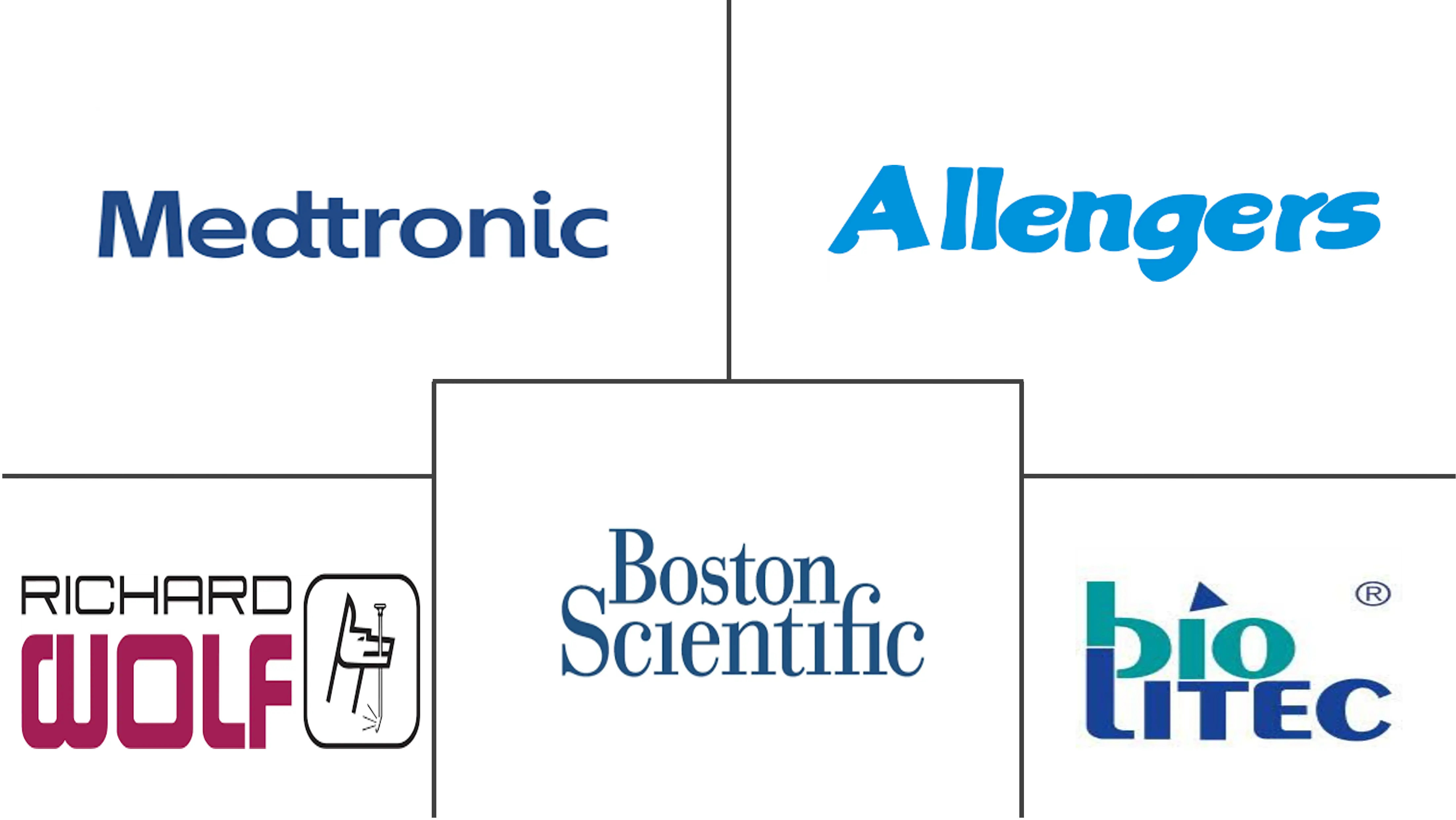Market Size of Urology Laser Industry

| Study Period | 2019 - 2029 |
| Base Year For Estimation | 2023 |
| Forecast Data Period | 2024 - 2029 |
| CAGR | 5.51 % |
| Fastest Growing Market | Asia-Pacific |
| Largest Market | North America |
Major Players
*Disclaimer: Major Players sorted in no particular order |
Urology Laser Market Analysis
The urology laser market was valued at approximately USD 944.79 million in 2020 and is expected to record a CAGR of 5.51% over the forecast period.
The COVID-19 pandemic is expected to significantly impact the market's growth. In addition to the effects of the coronavirus on public health, there has been the collateral effect of nearuniversal disruption and cancelation of surgical services, which had unprecedented implications for surgical services and patients with surgical conditions. Operating theaters and anesthesia machines are being temporarily converted to respiratory support units in regions with a high disease burden. Additionally, as per the study titled, 'Elective Surgery Cancellations due to the COVID-19 Pandemic: Global Predictive Modeling to Inform Surgical Recovery Plans,' published in May 2020, approximately 2.5 million urological benign surgeries were reported to have been canceled during the peak disruption of the COVID-19 pandemic. Over the coming weeks, healthcare workers, including urologists, may face increasingly complex challenges. Thus, they should adopt the triage strategy to avoid wasting medical resources. They should also endorse good protection policies to guard against infection when dealing with COVID-19 patients. Owing to the abovementioned factors, the pandemic is likely to have a short-term negative impact on the market studied due to the postponed elective surgeries.
One of the major factors driving the market studied is the high prevalence of urologic conditions worldwide. The prevalence of urinary incontinence is higher in women than in men. According to the Global Forum on Incontinence, 2020, urinary incontinence affects between 4-8% of the population or the lives of almost 400 million people worldwide. Also, the rising adoption of minimally invasive surgical procedures in holmium systems and thulium laser treatment systems is one of the major factors propelling the market for urology lasers. These systems offer several benefits, such as greater efficiency, safety, and rapid recovery, resulting in increased demand for thulium and holmium systems.
Furthermore, laser procedures provide benefits such as faster recovery, shorter hospital stays, decreased blood loss, and lower overall body pain resulting from smaller incisions. Hence, these systems' reliability and safety features are expected to drive market growth. Additionally, key players in the market studied are focusing on frequent product developments and approvals, which is expected to substantially drive the market during the forecast period. For instance, in June 2020, Olympus launched its new Soltive SuperPulsed Laser System (Soltive Laser System), a new application of thulium fiber laser technology designed for stone lithotripsy and soft tissue applications. Thus, such factors are likely to drive the market's growth during the forecast period.
Urology Laser Industry Segmentation
As per the scope of this report, urological lasers are medical devices used to treat various urological diseases, including benign prostatic hyperplasia, urolithiasis, and non-muscle-invasive bladder cancer. The urology laser market is segmented by laser type, application, and geography. By laser type, the market is segmented into holmium laser system, diode laser system, thulium laser system, and other laser types. By application, the market is segmented into benign prostatic hyperplasia, urolithiasis, non-muscle-invasive bladder cancer, and other applications. By geography, the market is segmented into North America, Europe, Asia-Pacific, Middle-East and Africa, and South America. The market report also covers the estimated market sizes and trends for 17 different countries across major regions globally. The report offers the value (in USD million) for the above segments.
| By Laser Type | |
| Holmium Laser System | |
| Diode Laser Systems | |
| Thulium Laser System | |
| Other Laser Types |
| By Application | |
| Benign Prostatic Hyperplasia | |
| Urolithiasis | |
| Non-Muscle-Invasive Bladder Cancer | |
| Other Applications |
| Geography | ||||||||
| ||||||||
| ||||||||
| ||||||||
| ||||||||
|
Urology Laser Market Size Summary
The urology laser market is poised for growth, driven by the increasing prevalence of urologic conditions and the rising adoption of minimally invasive surgical procedures. The market is experiencing a shift towards advanced laser systems, such as holmium and thulium laser treatment systems, which offer benefits like enhanced efficiency, safety, and quicker recovery times. These systems are particularly beneficial for treating conditions like benign prostatic hyperplasia (BPH) and urinary incontinence, which are more prevalent among the aging population. The market's expansion is further supported by ongoing product developments and technological advancements, such as Olympus's introduction of the Soltive SuperPulsed Laser System, which utilizes thulium fiber laser technology for various applications.
The COVID-19 pandemic has had a short-term negative impact on the market due to the postponement of elective surgeries, but the market is expected to recover as healthcare providers resume focus on urology treatments. North America, particularly the United States, dominates the market, driven by the high prevalence of urological disorders and a preference for minimally invasive procedures. The region's growth is supported by rising healthcare expenditure and the emergence of novel technologies. The market is moderately competitive, with major players like Olympus Corporation, Boston Scientific Corporation, and Medtronic leading through strategic alliances and new product launches. These factors collectively contribute to the anticipated growth of the urology laser market over the forecast period.
Urology Laser Market Size - Table of Contents
-
1. MARKET DYNAMICS
-
1.1 Market Overview
-
1.2 Market Drivers
-
1.2.1 Increase in Prevalence of Urological Disorders
-
1.2.2 Technological Advancements
-
1.2.3 Rising Demand for Minimally Invasive Surgical Procedures
-
-
1.3 Market Restraints
-
1.3.1 High Cost of Laser Systems
-
-
1.4 Porter's Five Forces Analysis
-
1.4.1 Threat of New Entrants
-
1.4.2 Bargaining Power of Buyers/Consumers
-
1.4.3 Bargaining Power of Suppliers
-
1.4.4 Threat of Substitute Products
-
1.4.5 Intensity of Competitive Rivalry
-
-
-
2. MARKET SEGMENTATION (Market Size by Value - USD Million)
-
2.1 By Laser Type
-
2.1.1 Holmium Laser System
-
2.1.2 Diode Laser Systems
-
2.1.3 Thulium Laser System
-
2.1.4 Other Laser Types
-
-
2.2 By Application
-
2.2.1 Benign Prostatic Hyperplasia
-
2.2.2 Urolithiasis
-
2.2.3 Non-Muscle-Invasive Bladder Cancer
-
2.2.4 Other Applications
-
-
2.3 Geography
-
2.3.1 North America
-
2.3.1.1 US
-
2.3.1.2 Canada
-
2.3.1.3 Mexico
-
-
2.3.2 Europe
-
2.3.2.1 Germany
-
2.3.2.2 UK
-
2.3.2.3 France
-
2.3.2.4 Italy
-
2.3.2.5 Spain
-
2.3.2.6 Rest of Europe
-
-
2.3.3 Asia-Pacific
-
2.3.3.1 China
-
2.3.3.2 Japan
-
2.3.3.3 India
-
2.3.3.4 Australia
-
2.3.3.5 South Korea
-
2.3.3.6 Rest of Asia-Pacific
-
-
2.3.4 Middle-East and Africa
-
2.3.4.1 GCC
-
2.3.4.2 South Africa
-
2.3.4.3 Rest of Middle-East and Africa
-
-
2.3.5 South America
-
2.3.5.1 Brazil
-
2.3.5.2 Argentina
-
2.3.5.3 Rest of South America
-
-
-
Urology Laser Market Size FAQs
What is the current Urology Laser Market size?
The Urology Laser Market is projected to register a CAGR of 5.51% during the forecast period (2024-2029)
Who are the key players in Urology Laser Market?
Boston Scientific Corporation , Richard Wolf GmbH , Medtronic, ALLENGERS MEDICAL SYSTEMS LIMITED and biolitec AG are the major companies operating in the Urology Laser Market.

